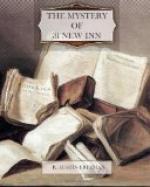This conclusion was, indeed, to some extent negatived by a deep indentation on the bridge of the nose, evidently produced by spectacles, and by marks which I looked for and found behind the ears, corresponding to the hooks or “curl sides” of the glasses. For those spectacles which are fitted with curl sides to hook over the ears are usually intended to be worn habitually, and this agreed with the indentation on the nose; which was deeper than would have been accounted for by the merely occasional use of spectacles for reading. But if only one eye was useful, a single eye-glass would have answered the purpose; not that there was any weight in this objection, for a single eye-glass worn constantly would be much less convenient than a pair of hook-sided spectacles.
As to the nature of the patient’s illness, only one opinion seemed possible. It was a clear and typical case of opium or morphine poisoning. To this conclusion all his symptoms seemed to point with absolute certainty. The coated tongue, which he protruded slowly and tremulously in response to a command bawled in his ear; his yellow skin and ghastly expression; his contracted pupils and the stupor from which he could hardly be roused by the roughest handling and which yet did not amount to actual insensibility; all these formed a distinct and coherent group of symptoms, not only pointing plainly to the nature of the drug, but also suggesting a very formidable dose.
But this conclusion in its turn raised a very awkward and difficult question. If a large—a poisonous—dose of the drug had been taken, how, and by whom had that dose been administered? The closest scrutiny of the patient’s arms and legs failed to reveal a single mark such as would be made by a hypodermic needle. This man was clearly no common morphinomaniac; and in the absence of the usual sprinkling of needlemarks, there was nothing to show or suggest whether the drug had been taken voluntarily by the patient himself or administered by someone else.
And then there remained the possibility that I might, after all, be mistaken in my diagnosis. I felt pretty confident. But the wise man always holds a doubt in reserve. And, in the present case, having regard to the obviously serious condition of the patient, such a doubt was eminently disturbing. Indeed, as I pocketed my stethoscope and took a last look at the motionless, silent figure, I realized that my position was one of extraordinary difficulty and perplexity. On the one hand my suspicions—aroused, naturally enough, by the very unusual circumstances that surrounded my visit—inclined me to extreme reticence; while, on the other, it was evidently my duty to give any information that might prove serviceable to the patient.




